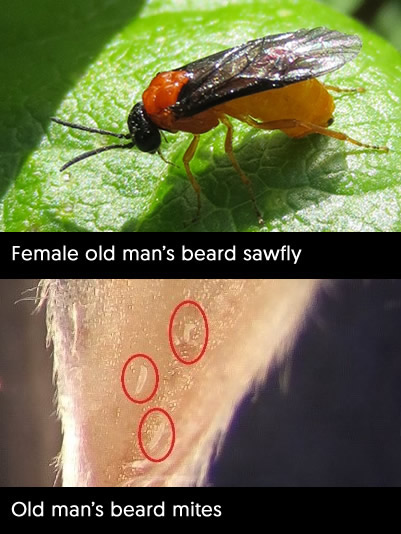Old Man’s Beard Agents Show Promise

Four biocontrol agents have been developed for old man’s beard in New Zealand, three of which were released two decades ago in the late 1990s. The first agent, a leaf-mining fly (Phytomiza vitalbae), established and spread rapidly. Unfortunately the fly accumulated native parasitoids, which maintain the agent populations at low densities, and damaging outbreaks are now quite rare. The second agent, a fungus (Phoma clematidina), did not persist and is believed to be outcompeted by native fungi.
The third agent, a sawfly (Monophadnus spinolae), was released over several years from 1998 at multiple localities, but due to adverse weather and human disturbance many sites were lost. In 2015 a few sawflies were spotted at an old man’s beard site near Nelson, confirming they are established but persisting at very low numbers, having remained undetected for almost 20 years. Establishment of this sawfly population was speculated to be constrained by genetic bottlenecks during rearing due to the production of male-biased progeny.
The discovery was nevertheless encouraging, and the project was revived with the importation of a new sawfly population from Serbia into containment at Lincoln in 2019. Mass-rearing methods were improved and geared towards obtaining a more balanced sex ratio. In late 2019, thousands of sawfly larvae along with mated adult females were released in Amberley in the Waipara district in the Canterbury Region in the South Island.
Later in the season, in February 2020, the release site was visited by both technicians working on the project at the time, Arnaud Cartier and now-retired, Lindsay Smith. “It didn’t take us long to see adults flying around, which would have been second generation adults. We even saw some larvae feeding on the leaves,” enthused Arnaud.
The site was checked again this summer, and both adults and larvae were observed. “Given the complex life history of this agent, it was fantastic to see adults this summer for the second year in a row,” said Arnaud. “We are now very hopeful that sawfly numbers will steadily increase, which will eventually allow for collection and redistribution of adults and larvae to other old man’s beard infestations,” he added.
The fourth and last agent approved for release against old man’s beard is an eriophyid mite. Feeding by this leaf- and bud-galling mite stunts plant growth and reduces shoot production. This has been another very difficult agent to work with, and the first few attempts at establishing a viable laboratory colony failed. Persistence and hard work paid off, however, and a mite colony was finally established with the importation of new material from Serbia in 2019, hand delivered by Dr Biljana Vidovic (University of Belgrade). The microscopic mites were painstakingly transferred on pinheads to fresh plant material and finally … success! After receiving MPI approval to remove the mites from containment, the infested plants were transferred to an outdoor shadehouse for mass-rearing.
Over the past 18 months the mites have slowly transferred to fresh plants placed alongside the original mite-infested plants removed from containment. “I regularly dissect buds to monitor the population and have found that even a small number can effectively stunt new growth. The damage has become more obvious this summer, presumably due to increasing numbers, with plants now showing galled and deformed leaves,” explained Arnaud.
Even more encouraging, the mites have been found on old man’s beard plants growing in other shadehouses, and even on wild plants growing on the Lincoln campus. “At first, I was very surprised that they had dispersed so far and so quickly. I even had to get confirmation of the ID from a mite expert,” said Arnaud. “However, since eriophyid mites disperse passively on winds, a phenomenon known as ‘ballooning’, it isn’t really surprising that they have established themselves on nearby plants. These early findings suggest natural dispersal in the field should be good,” he concluded. And the last bit of good news – the first official field releases of the old man’s beard mite will go ahead later this year in spring.
Contact

